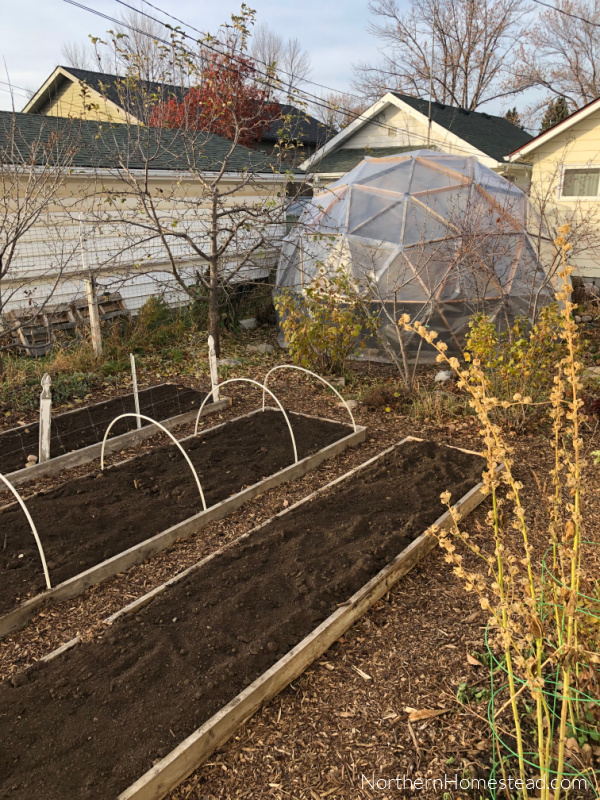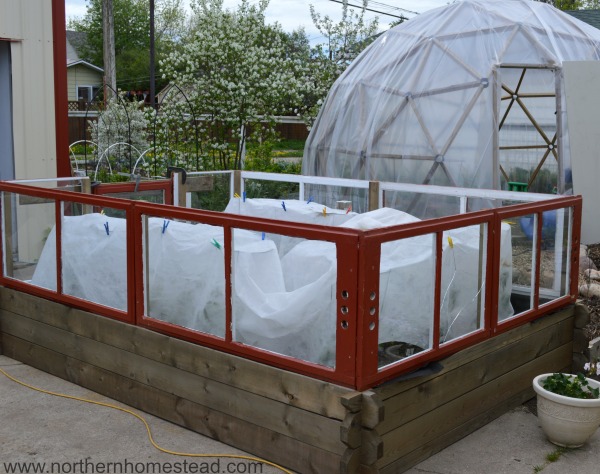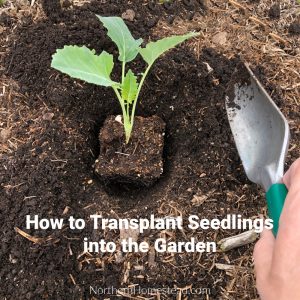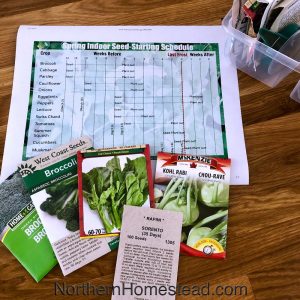When to plant what in a vegetable garden? This is an important question. The Northern Vegetable Garden Planting Schedule answers this question in a nontraditional way.
The general rule for planting dates in our area seems to be very simple: plant everything on the long weekend in May. This has to do with our last frost day, which is around May 25, and Canadian Victoria Day, a holiday that happens to be around the last frost day. Many gardeners have followed this rule for years, more or less successfully.
Following this general rule might be a good idea if you are a brand-new gardener just trying your hand at growing. Start small and keep it simple. You might also want to read the article about starting a garden blog. Lots of helpful information there.
If you have gained some experience in gardening, we recommend not following the traditional way, and here’s why.
3 good reasons why not to plant all at once
1. Some plant varieties could and should be planted long before the last frost date. Plants like spinach do better in cooler conditions. Plants like broccoli are better harvested before the cabbage butterfly lays eggs (late July – early August). Additionally, plants like onions require a cool start and a longer growing period. Those are all winter crops that do not mind some frost, especially when young. Other cold-loving vegetables are kale, cabbage, Brussels sprouts, parsley, peas, lettuce, beets, carrots (partly), radishes, Swiss chard (and more).
2. Some plant varieties should be planted after the last frost date. Those are summer crops and grow much better in warmer soil. Cold and rainy weather, which often occurs immediately after the last frost day, can harm or even kill them. Eggplants, peppers, cucumbers, and squash do better when planted after the last frost date, when the weather is warm and favorable. See also the indoor seed starting schedule for those plants.
3. It is a lot of work to plant everything at once. Even if there were no other reason to plant plants at different times, this would be a big one for us. I can understand when gardeners complain about gardening being such hard work if they plant everything at the same time, and then weed the whole garden at the same time (as is the case if you plant everything at the same time), and then have to harvest everything pretty much at the same time, also.
We like things simple: plant, weed, harvest – all staggered over a period of time – that way, gardening is enjoyable. Succession planting gives us a jump start and a productive season in our garden plot. For example, Plant overwintering spinach in the fall, followed by cucumbers in June when the spinach is harvested.
Northern Vegetable Garden Planting Schedule

The weather in our area is very unpredictable. In the years we have lived here, we have experienced temperatures as low as -20C (-4F) in late April and snow in early June. It is almost impossible to go by a planting date. There are some guidelines and average frost dates, but the weather conditions vary significantly from year to year. Nevertheless, it is worth watching the weather and planting cool-season vegetables as soon as possible and warm-season crops as late as needed.
Late April: Spinach, peas, onions, lettuce, parsley, kale, and transplants from the whole cabbage family (e.g., cauliflower, which is better when planted in early May).
Early May: Root vegetables, such as beets, carrots, and radishes, and leafy greens like Swiss chard.
Late May: Beans, corn, squash (zucchini), potatoes, tomatoes transplants (might need protection).
Early June: Transplants: Cucumbers, eggplants, peppers, squash (winter).

You may also like the Spring Indoor Seed-Starting Schedule. The schedule includes dates for both seed starting and planting out seedlings.
Adapting the planting schedule to your climate
Your last frost date might not be May 25. Make your own schedule by using your local conditions and frost dates. To find your average last frost date, visit the links for Canada and the USA. Enter your city or postal code, and the available dates will be displayed.
For example, move everything a month back if your last frost date is April 25 instead of May 25. If your last frost date is June 10, move everything forward two weeks. So, plant the cold-weather crops in early May instead of late April.

In a high-elevation mountain climate, the weather can be pretty unpredictable. We experience this variability in our area. One option is to plant everything a bit later, while another is to be prepared to cover plants if necessary. Read more about how to protect plants from late spring frost.
Preparing the garden for planting

The traditional method of planting an entire garden all at once is closely related to how the garden is prepared for planting. Once the soil has been tilled, planting needs to occur soon afterward; otherwise, the soil will become hard and overrun with weeds again.
Our planting schedule is great for no-till gardening methods. With proper care, your garden will always be ready for planting, whether you use lasagna, mulch, or square-foot gardening methods. Read more on maintaining a no-till garden here.
The story goes that the no-till method became popular due to Ruth Strout, who was tired of waiting for the tiller. So she planted and mulched and never looked back at the tiller. Find her inspiring books here.
Expanding the growing season

We like to extend the growing season and find it simplest to do so in the spring. Young, small plants are relatively easy to cover. We often use glass jars for that. It’s an old method where garden cloches were used even for commercial growing. For home garden use, I find glass jars work just fine. As long as the jar is tight, there is not so much danger of overheating as one would think. Moisture builds up in the jar, creating its own microclimate.
Frost blankets are lightweight and can be put over the plants with or without support wiring. It would help if you weighted them down so the wind wouldn’t blow them away. The Floating Row Cover can be left on all day during windy and cool weather.

A window-protected garden bed is an excellent idea in a cold climate, allowing you to plant out and grow heat-loving plants a bit earlier to get a head start, even for tender plants.
One of the most enjoyable ways to extend the growing season is with a greenhouse. A greenhouse is not just great for seedlings in early spring; in a cold climate, you can plant and grow a greenhouse garden.
Do you have the courage to break some general rules?
We invite you to subscribe to Northern Homestead and follow us on Instagram, Facebook, or Pinterest for the latest updates.












I just discovered your blog and am really enjoying reading through your posts. This one is particularly helpful as it’s going to be our first growing season in AB where we have access to a garden!
So glad I can be of some help! gardening in AB is challenging but so much fun at the same time. Happy gardening!
Agreed! I’ve been gardening in Edmonton for the past 6 years (lived here my whole life), and I’ve slowly added a bit more each year.
I wish there were dates on your posts though!
My indoors seed starting schedule has dates. It is easy to figure out the dates for planting these plants out. However, for outdoor planting, it is better to go by the weather. Sometimes the weather is cooler or warmer as the dates will tell you. Hope this helps. Also, make sure to follow us on facebook if you can, we share more actual things there.
Pfft! It’s even worse in Manitoba! Glad I found your site.
Welcome, glad to have you here! Yes winter in Manitoba are kind of brutal, but I hear summers are a bit warmer than here. Happy gardening anyways (once all the snow is gone ;))!
The problem we always run into is it’s too wet to plant. Right now i’d love to be planting. Maybe I need to get some pots. Sigh….. So wet.
Have you tried mulching? That could help a lot with the wetness – just a thought.
What do you mean by trying mulching? We also are too wet to plant where it is obvious the previous owners had their garden. In CA you mulch to hold the moisture in your garden by laying it on top of the dirt. How do you use mulching to cut the mud into good plantable dirt?
Mulch like wood chips work both ways because wood can hold the excesses moisture and give it back as needed. You will need a thick layer though to work. A garden mulched with wood chips is never muddy.
You could also try raised beds, They dry out faster, and the snow melts off them faster.
You are so right, Alex. And if you add some protection to the raised bed, you can plant even sooner.
I stumbled across your blog this past weekend and can’t say enough how much I appreciate your wonderful posts. I also live in Alberta and it is so nice to be able to learn from your gardening experience in this province! I have a large family and use gardening to lower our food costs, but I also really enjoy working in the dirt. This year I’ll be experimenting with a cold frame and hoop houses and am excited to see how this will lengthen our growing season. I’ll definitely be trying to plant out my broccoli early this year (like you recommend) – I hope this will solve the cabbage worm problem. Thanks again!
Welcome Vanessa and thank you for your kind words. Gardening in Alberta is challenging for sure, but also fun and rewarding.
I need to dig up that calendar for planting here in Central Florida…I’m probably behind on everything LOL One of these days I’m gonna comment to you on what I actually PLANTED!!!
Looking forward to that day! And do not stress about being late, after all you got all year to plant ;). I am I bit jealous.
Here in the south, of course, we plant earlier than you do. I actually bought some seeds yesterday to start inside (after reading one of your posts). I’ve never planted seeds, just always bought the plant. I’m so excited!
Thank you, you made my day! So happy to have encouraged you to start planting! Go girl go!
And I thought Massachusetts was awful for gardening! We still have a foot of snow in our back yard, but I got my onion seeds started indoors yesterday with my daughters. While I’m chomping at the bit, I’ve learned the hard way not to rush nature. I’ll pull the straw mulch off the raised bed once the snow is gone to help the soil warm faster, but I WILL NOT put a seed into the ground until it’s time! (I chant that daily.)
Thanks for a great post!
Yes, there are better places to garden than where we are, but we try to make the best out of it. And in the end, it amazes me every year how much we actually harvest. So thankful!
I planted seeds the first time Feb. 2nd. Those are doing very well, flowers and herbs. The Sunflowers are ready to go into the ground!
So true- you need to bend the rules a bit when it comes to planting time- I think you’re lucky to be able to get out in the garden in late April- usually in Mb early may is the earliest- you can manage- but it’s worth it to get that early stuff in!
It is worth it to be as early as possible and as late as needed. happy gardening!
Thanks for sharing on Homestead Barn Hop. Nice summary for beginning gardeners.
Thank you so much for posting this. I’ve been itching to get out in my garden and plant (I’m a zone 3/4) and was going to go with the suggested planting times from the seed manufacture, but they are based out of Mississauga, ON, so I was a little unsure, as I’m in the North Okanagan region of BC.
Now I’m thinking I might go half way between your dates and theirs and have more success.
Hi Ricki, the best way is to find out the last frost day in your area. It might be different than what we have or what ON has. Then decide what you can plant before, on time and after the last frost day.
Very helpful gardening post. Thank you. I need all the helpful tip I can get
You are welcome Janet! Gardening is always learning.
Love this post! Thank you…..
I used to make a number of plantings so everything wouldn’t be ready at once, but despite the different planting times all the beans were all ready at once. The same for peppers, squash, onions, and tubers. The only things that didn’t were ever baring and things like strawberries that all fruited at the same time. Succession planting doesn’t work for short summers. When the plants get the right light and temperature, they grow like crazy because they know snow can happen at any time(this is true of heirloom and locally acclimatized seed). I find the heirloom seeds produce better and taste better then seeds meant for an other climate.
You right, short season planting and harvesting time window is very narrow. Heirloom and locally acclimatized seeds are great, or at least from a climate close to the one you live in.
Such good information! Thank you for the simple approach to gardening. We are new arrivals to Maine from CA. We were hobby gardeners at best in CA. Here we want to ‘grow into’ growing an abundance of food. We now have the land we just need baby steps of knowledge to begin our journey. You have given us a good, strong start.
Thank you Jeannie for your kind words. Gardening is like riding a bike, you learn it by doing it. Every year you will get a little better. Growing an abundance of food is a great goal, go for it!
In Manitoba, we have some raised beds that are ready for planting these early crops. Peas and onions went in yesterday. I also plant some Red Norland potatoes around this time. They don’t like frost, but if a frost is predicted, I will hill the tender young leaves with dirt and they will survive just fine. I also look closely at the garden to see what’s coming up on its own for clues about plant hardiness. Chamomile (self-seeded from last year) is up. Onions and leeks that l left in the garden over the winter have greened up. I’ll let these flower, then save the seeds. Parsley has even over-wintered under the thick blanket of snow and is sprouting new green leaves. Strawberries are greening up, and rhubarb is starting to poke its nose out. I completely agree with you about not following the May long week-end planting rule. It’s so much more manageable and productive to do it the way you suggest.
I haven’t seen any mention of soil temperature. A very seasoned gardener told me she plants as soon as the soil reaches 70F. We live in NB in zone 4a-b.
It’s because we do not go by soil temperature. I just measured the soil temperature in the raised protected garden it is 55F (Peas are growing here), and outside in the garden 45F (Spinach is growing here). Even in the greenhouse, it is only 59F right now. If I remember I will take measurements in late May again, to see if we have reached 70F.
Another Manitoban here, and I also don’t plant only on Victoria Day. Your list of Late April and Early Many seeds go in the ground just as soon as I can work the soil without compacting it. As for the rest, I watch to see what Mother Nature is doing. Old folks around here have told me to plant those “warm season” crops when the saskatoons or the wild plums are in bloom, or when “the oak leaves are the size of a mouse’s ear”, lol. I shouldn’t laugh because it works. I do have issues with the mulching for several reasons. Firstly, it’s very windy here and I rarely get a chance to collect a lot of leaves, and even if I did I’m afraid they would all blow away from whereever I put them anyway. Also a mulched bed will be very slow warming up for planting in the spring, compared to bare soil. Our season is short and I don’t want to wait any longer than I have to for planting. I garden on heavy clay loam and while it’s very fertile it also compacts easily and I have to stay off it when it’s the least bit wet. So while I’d love to be adding the organic stuff to the garden I’m not seeing a clear way to do it. I do rotate my plantings and have gardened here for over forty years and am not seeing any loss of fertility, which is kind of strange, I suppose.
Old folks wisdom is precious. You right, leaves or straw would not work for a windy area. Wood chips could be your best choice. You could also just mulch the paths, so your garden is accessible in any weather and then see from there how you like it. We do not find that wood chips hinder the soil to warm up, they are dark (composted) as well, so there is not much of a difference, if at all. Glad to hear your soil is so fertile, an advantage that prairie gardeners often have.
Just coming across this and loving all of your content! Thank you for sharing! Gardened in the front range of Colorado for 12 years, but kicking off my first season higher up in the true mountains, zone 3. We are at 7,000 ft but more sun angle benefit so guessing very similar (and your description of weather patterns are familiar!) thanks again!
Welcome, Emily to the world of cold climate gardening and to our blog. Happy to hear you find what we share helpful.
This is a great guideline and so nice to see one for northern climates. I have a cold frame green house ( no heat and single layer plastic – 14×10. ), and two large veggie gardens. We rely heavily on preserving our harvest as it is a remote location and accessing fresh affordable produce can be an issue. I live in the moutains of the interior of BC and frost, freeze and snow are always a challenge. This year I used a buried soil cable with a thermostat in my raised bed cold frame green house. It allowed me to put my tomatoes in a few weeks earlier than I normally would. This, a heat lamp from the chicken coop on a timer for “just encase” and two covers of floating row cover at night, have allowed my tomatoes to do okay and have an early start even when I was surprised with -5 C one night. Fall comes so early here with hard frosts. Getting tomatoes in early enough and out late enough is a challenge. I really enjoy your site . Your suggestions on hardening off tomatoes saved me a lot of time this year. 🙂
Thank you, we are always happy to hear that the information we share is helpful. Thank you for sharing your experience, you got some great ideas there for someone in a similar situation.